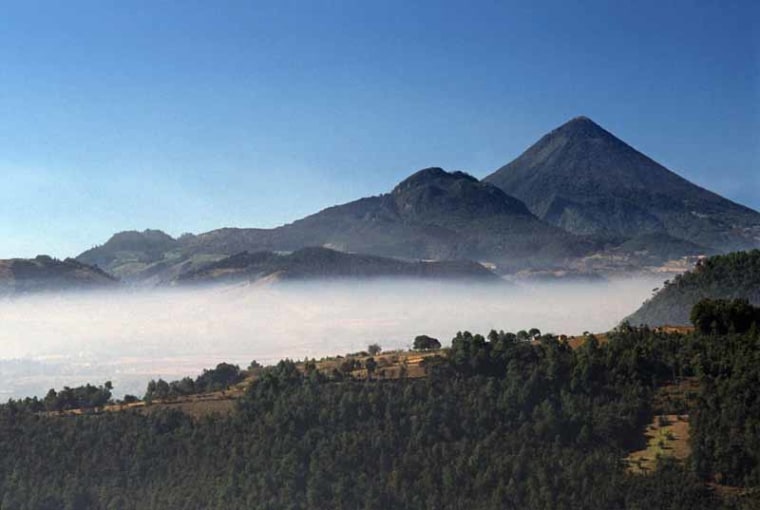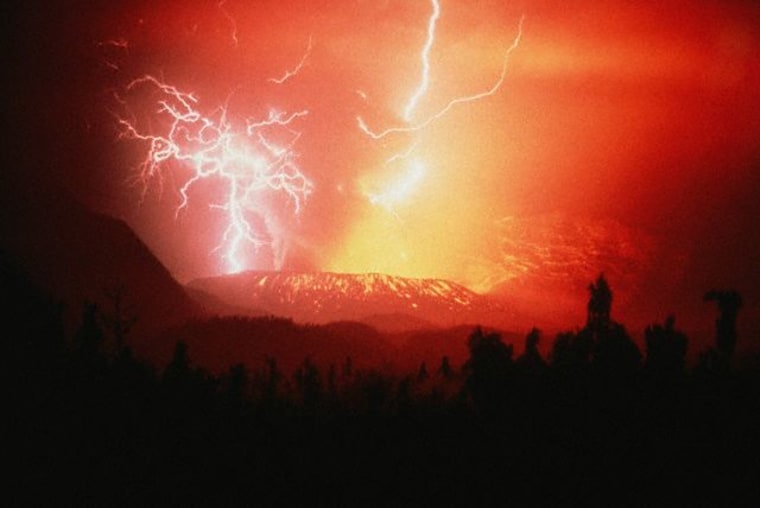“Volcanoes form mountains; supervolcanoes erase them. Volcanoes kill plants and animals for miles around; supervolcanoes threaten whole species with extinction by changing the climate across the entire planet ... Is it going to blow again?”
What sounds like an advertisement for Hollywood's latest apocalyptic blockbuster are actually the words of Joel Achenbach, Washington Post reporter and science writer. In the August 2009 issue of National Geographic, he wrote about the Yellowstone Supervolcano that sits beneath our beloved national park. When Yellowstone eventually blows sometime in the next 100,000 years (or so), it will make Mount St. Helens look like a geological indigestion.
Fortunately, supervolcanoes are very rare. Volcanoes, however, are all around us.
“On any given day there are probably 25 volcanoes erupting around the world,” William Rose, a professor of Geological Engineering and Sciences at Michigan Technological University, told Space.com. Rose described volcanoes as an “immediate and constant threat to people around the world.”
To identify the world's deadliest volcanoes, we must sometimes rely on educated guesses and estimates culled from contemporary accounts. As for future deadliness, we can refer to the International Association of Volcanology and Chemistry of the Earth's Interior (IAVCEI), which has compiled a list of the 16 most dangerous volcanoes in the world. These are called the Decade Volcanoes.
Guatemala's Santa Maria volcano is on the IAVCEI's list. The volcano known locally as “Gagxanul,” in the Sierra Madre range, had sat quietly for more than 500 years. But when she exploded in 1902, her blast was the 20th century's third-most violent eruption — after Alaska's Novarupta in 1912 and Pinatubo in the Philippines in 1991.
The explosion is described as “colossal” on the Volcanic Explosivity Index, or VEI, and destroyed 120,000 square miles of countryside and killed 5,000. More died from malaria in the weeks following. In recent decades, Santa Maria herself has been relatively quiet, but a new lava dome formed nearby in 1922. Named Santiaguito, this baby volcano has already destroyed villages, roads and bridges with deadly flows of volcanic material.
Central and South America are highly volcanic areas. History has recorded hundreds of eruptions across the region, but none have taken as many lives as the eruption of Colombia's Nevado del Ruiz. Despite warnings of imminent eruption, the residents of Armero, in the Andean region, failed to evacuate their homes. (A number of false alarms had inured them to the danger.)
When the mountain finally exploded on November 11, 1985, a deadly surge of volcanic material engulfed the entire town, killing more than 23,000. Today, memorial sites stand where much of the city and victims remain buried under solidified mud and ash.
When we think of volcanoes, we think about lava. And when we think of lava, we think of heat. That's why Iceland doesn't immediately come to mind when considering deadly volcanoes. But the 40,000-square-mile island was created by — and still sits atop — countless volcanoes that are responsible for the country's famous hot springs. In 1783, the world learned of Iceland's potential for geological catastrophe with the Laki eruption, which released clouds of poisonous hydrofluoric acid and sulfur dioxide into the atmosphere. Three-quarters of Iceland's cattle were killed, resulting in the Haze Famine that took 10,000 lives. Thousands more Europeans may have died in the unusually harsh winter caused by the debris thrown into the atmosphere.
Volcanoes specialize in throwing ash, pumice and other harmful materials into the air. In fact, that's usually how many victims perish. In 79 A.D., Mt. Vesuvius covered Pompeii and its sister city, Herculaneum, beneath 60 feet of ash, killing an estimated 10,000. That's not the last time the world felt the wrath of Italy's sole mainland volcano — in 1631, Vesuvius claimed another 6,000 lives, a 1906 eruption killed 100 and several villages were lost in 1944.

For good reason, Vesuvius is considered the most dangerous volcano in Europe. Volcanologists estimate that in the first 15 minutes of a large-scale eruption, everything within a four-mile radius of the blast could be destroyed. Today, approximately one million people live within that kill zone, with another two million nearby.
Hawaii has the world's most active volcano, Kilauea, but it doesn't rate when we turn to the plural, volcanoes. That honor goes to Indonesia. Thanks to its prime position along the Pacific Ring of Fire, this collection of 17,000 islands claims the most active volcanoes in the world. It can also claim the incident whose name has become synonymous with cataclysm: Krakatau. When this island volcano blew its top in 1883, 36,000 perished.
But even Krakatau isn't the deadliest eruption the world has witnessed. It's not even the deadliest eruption in Indonesia. That honor goes to Mt. Tambora, whose massive 1815 eruption killed 12,000 in the blast and another 80,000 from starvation. That's not the end of the story. Tambora ejected so much ash into the atmosphere that the world experienced an artificial winter.
In fact, 1816 is known as the Year Without a Summer — thanks in no small part to Tambora's eruption. Several regions of the U.S., normally warm, saw snow during the months of July and August. Best estimates may put Tambora's death toll at 92,000 — but it's impossible to calculate the global havoc caused by this geological disaster. Like every other volcano on this list, Mt. Tambora remains active.
